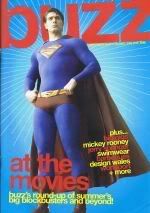The Last Exorcism (2010)
 The Last Exorcism is yet another in a long string of recent movies dressed up to look like cheap documentaries or found footage: the conceit here is that Rev Cotton Marcus, a preacher popular for his showmanship, wants to expose exorcism as the massive scam that it is. He's got a young son and is disturbed by the stories of children being killed mid-exorcism by the people supposedly trying to "save" them. So, with a small documentary crew in tow, he sets off to an isolated farm where the Sweetzer family is battling all kinds of demons, determined to show the world that exorcism is nonsense.
The Last Exorcism is yet another in a long string of recent movies dressed up to look like cheap documentaries or found footage: the conceit here is that Rev Cotton Marcus, a preacher popular for his showmanship, wants to expose exorcism as the massive scam that it is. He's got a young son and is disturbed by the stories of children being killed mid-exorcism by the people supposedly trying to "save" them. So, with a small documentary crew in tow, he sets off to an isolated farm where the Sweetzer family is battling all kinds of demons, determined to show the world that exorcism is nonsense.
Of course, it all goes horribly wrong.
The first half an hour of The Last Exorcism works pretty well: one of the challenges for this kind of movie is setting up why things are being filmed, and Rev Marcus's motivations for wanting to get out of the exorcism game are believable enough. The point where it all starts to fall apart is when the crew arrive at the Sweetzer's farm, and the father of the family, Louis, tells him to turn off his camera. There are several minutes of argument in the film, including the screen fading to black for a little while, and a conversation we can't hear between Marcus and Louis Sweetzer being filmed from behind glass. But the film we're watching is supposed to be a documentary, and it's been edited - it's not continuous found footage like in Cloverfield, there are cuts and captions and music added in - so why has this scene been left in? It's awkward, and it's the first sign that the filmmakers haven't entirely got a handle on what exactly they're creating here. And it only gets worse as the film progresses.
The Last Exorcism is, at least, reasonably careful not to commit itself to any one explanation for the weirdness that's going on at the farm: Nell Sweetzer, the supposedly possessed girl, appears to be sweet and innocent, while her brother is sullen and obnoxious, and her father is a scarily over-protective religious zealot who drinks too much and, possibly, sexually abuses his daughter. The film offers us two explanations for all the violence and spookiness that's going on: either Nell is really possessed by a demon, or she's a damaged girl who's been unbalanced by the death of her mother, extreme isolation, religion, and abuse. Because the initial premise of the film is that Rev Marcus wants to prove that exorcism isn't real, though, it seems fairly reasonable to expect that the film will show us that sometimes, demons are real - otherwise, what's the point? In that case, The Last Exorcism would join the ranks of horror films where young girls are abused by their parents for their own good (and the good of everyone else) because they're evil/demonic/possessed, a trend that uncomfortably appropriates the hallmarks of abuse and justifies them. If the demon isn't real, then it's a sad story of a girl punished by her community for imaginary sins and mental illness in a way that feels too medieval to be happening in 2010, a condemnation of small town zealotry.
But the film can't seem to make up its mind, and rather than commit itself either way, it concocts an ending that makes gibberish of the whole endeavour. After conducting a second exorcism, during which Nell contorts herself into all sorts of painful positions (something that might have been a little more shocking if it wasn't used in the marketing campaign) it emerges that Nell is pregnant by a local boy, and the shame and fear of punishment from her puritanical father, combined with everything else she's had to go through, seems to explain her mental breakdown. A self-satisfied Marcus and crew prepare to leave town, but when they realise that Nell's story doesn't hold up, they decide to return to the farmhouse (instead of, at this point, calling the police, or some kind of social services) and ... it's difficult to explain what they find, it's so utterly nonsensical. When the crew get to the Sweetzer's farmhouse, they discover that the place is covered in pentagrams and other arcane symbols, daubed on the walls in blood. Outside, they discover some kind of Satanic ritual is in progress, with Nell screaming on an altar as she gives birth to something or other and Louis lashed to a pole. Among the hooded figures standing around the pyre is a local priest, who tosses the newborn baby into the fire. For a moment the film threatens to become The Wicker Man as Marcus musters what's left of his long-dead faith to break up the ritual. Brandishing a crucifix, he walks into the flames, a symbol we've already seen represented in Nell's primitive artwork. And the documentary crew, despite protesting numerous times about wanting to leave because things are getting too dangerous, hang around long enough to film all of this before finally, finally, turning tail and running, only to get murdered in the woods themselves.
And that's the end. It doesn't work. Nothing about the film works. Was Nell possessed? Who was the father of her baby - and why did the townsfolk kill it? An effective twist ending makes you reconsider everything else that happened in the film, viewing everything through the lens of the new information you've been given. The ending of The Last Exorcism is nonsense; it doesn't add anything, it actually makes the film even more incoherent. If Marcus and the crew were all killed that night, who put the documentary together? How did they get hold of the footage? And why did they edit it so badly? The structure of the film is a mess. If you're going to use sound as a plot element - Marcus rigs up speakers to emit demonic grunting during his fake exorcisms, Nell plays the recorder discordantly and creepily from inside her locked bedroom - then adding in extra sound cues during tense scenes ruins all of that. If you're going to try to make the film feel naturalistic, including moments where the camera is switched off and back on again, then you can't use quick cuts or multiple cameras to cover both sides of a conversation. If you're going to have your camera held by an actual character in the story (not that poor cameraman Daniel really got to have much in the way of characterisation or screentime) then you need to give them a convincing reason to keep filming when things get dangerous or difficult, and you can't use multiple angles on the same scene, or you destroy your audience's willing suspension of disbelief. It's just sloppy to mash up elements of traditional horror movie filmmaking with documentary making and figure no-one will notice - it's disrespectful to your audience. That faux documentary style gimmick is over-used already, and while The Last Exorcism initially seemed to have a pretty decent reason for employing it, it wasn't well thought through enough to work. The best thing about the movie is the acting, but while all the actors are great, they're let down by a weak script and a badly executed concept. Less of this kind of crap, please.










1 comment:
I thought the idea was that her father was right all along - the nice people in the church down the road were all devil worshippers and had got her possessed/impregnated by Satan or whatnot.
The son was still in with them which was why he left the note saying "Don't leave her alone with him" knowing that would raise their suspicions about the father and lead to them calling in the church to take care of things when they left, so they could get on with the birth/summoning ceremony.
Agreed that the acting and most of the script was good, but the ending was pretty ludicrous. I didn't flag the multiple camera angles but the music was completely uncalled for.
Post a Comment